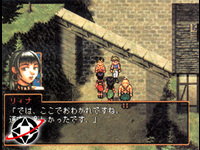|
|

|
PLATFORM
|
PS1
|
BATTLE SYSTEM
|

|
INTERACTION
|

|
ORIGINALITY
|

|
STORY
|

|
MUSIC & SOUND
|

|
VISUALS
|

|
CHALLENGE
|
Easy
|
COMPLETION TIME
|
20-40 Hours
|
|
OVERALL

|
+ Compelling narrative
+ Much-improved inventory
+ Varied and interesting 108 Stars
+ Attractive audio and video
- Poorly-edited text
- Unimpressive army battles
|
Click here for scoring definitions
|
|
|
Konami kept to the template of the first Suikoden for its sequel, a gutsy move considering what most PlayStation RPGs looked like in 1999. The results speak to the wisdom of Yoshitaka Murayama: Suikoden II has aged much better than many of its contemporaries. This game refines the ideas of its predecessor to achieve something much more memorable and engaging, a title that deserves to be experienced by as many RPGamers as possible.
Two young friends expecting to be demobilized from a Highland military unit get an unpleasant surprise when their commanding officer tries to have them killed at the behest of the country's prince. The prince's name is Luca Blight, and his plan is to revive the just-concluded war with the nation of Jowston by creating martyrs of the young men in this unit. His plan succeeds with the exception of the aforementioned pair, who are reluctant to part with their lives and choose flight instead. Their effort to flee homeward is undone by their new classification as both deserters and traitors, leaving them with no choice but to accept the offer of comaraderie a mercenary unit led by two veterans of the first Suikoden presents. Opposing Luca Blight's lust for combat is the situation into which they are dragged, and it sucks nations in also.
Suikoden II's tale does a stellar job of fleshing out the portion of the world with which its characters interact. It succeeds even more on a smaller scale, depicting the relationship of the player-named protagonist and his friend Jowy in a very convincing way. Their partnership is broken early in the game, and subsequently the pair find themselves leading opposing forces in the mighty clash for control of nations. Jowy's story gets much less screen time than the protagonist's once this occurs, but his tale is always interesting. Small scenes with the ample supporting cast make many of its members gain a substantial amount of interest instead of coming across as blank ciphers. The entire endeavor succeeds in creating a well-realized world peopled by interesting personalities, which is no small accomplishment.
Konami's much-derided localization is not quite as egregiously awful as some have characterized it, but is hardly without cause for complaint. The story comes across effectively and without much head-scratching from the player trying to elicit meaning from text that is only nominally in the English language. This does not make the work of the localizers a thing to be praised, as spelling, syntax, and grammar are infuriatingly inconsistent throughout Suikoden II. It simply means the wretched proofreading and editing of Konami's localization team is not so grievous as to render the events onscreen incomprehensible.
 Unlike real squirrels, these irritating rodents will stand and fight. Give them a suitable reward!
Unlike real squirrels, these irritating rodents will stand and fight. Give them a suitable reward!
|
|
An important aspect of the game is recruiting its 108 Stars of Destiny, a time-consuming but quite rewarding pursuit. Gathering all of them requires an even greater variety of tasks than the first game did, and figuring out the necessary methodology without a FAQ requires a great deal of dedication and guesswork. Doing so is nevertheless a compelling undertaking, one that fleshes out the locales and personalities within the game to a great extent.
The first Suikoden's combat has essentially been replicated for its sequel with only minor changes. A six-character party still dukes it out with enemies, and the protagonists possess weapons of varying ranges that mandate paying attention when setting up a formation to be sure everyone is capable of attacking. The series' reliance upon a certain number of charges for spell use instead of MP sets it apart from most other RPGs, along with its use of a blacksmith to strengthen weapons instead of replacing them outright at a shop. One decided improvement over the first Suikoden is that the player will always have the option to rearrange the party's formation when characters are forced in by the plot, plus there are two additional convoy slots to employ if someone set by the story would not fit with the current battle setup. Otherwise combat remains a brisk and efficient affair, helpfully free of the lengthy combat animations many developers considered necessary in the later PlayStation era.
Duels haven't changed much from the first Suikoden, offering one-on-one combat that operates according to rock-paper-scissors methodology. They offer a quick change of pace from standard battles without outwearing their welcome. Army campaigns are something entirely different in the second game, and their effort to incorporate Fire Emblem's style is considerably less appealing. The idea is that any unit which takes two hits in an army campaign is defeated, but a whole lot of luck and patience are often necessary to successfully strike foes with higher defense, and waiting around for someone to get lucky ceases to be interesting after some repetitions. Battles will usually end on their own if neither side scores a knockout blow within a certain number of turns, and army campaigns are a change of pace from standard combat most of the time, but their execution leaves quite a bit to be desired.
A massive improvement over the first game can be found in Suikoden II's inventory management, which cuts out much of the needless busywork from its predecessor. Putting on new equipment is an option when visiting the shopkeeper, and can also be done when trading items between separate inventories. The party item collection has a relatively low limit of material it can hold, necessitating some trips to the stores just to unload superfluous stuff, but otherwise dealing with inventory management is painless and effective.
 The rumors aren't entirely true: the English text IS more comprehensible than this.
The rumors aren't entirely true: the English text IS more comprehensible than this.
|
|
Suikoden II superficially resembles its predecessor very closely in visual quality, but a closer look makes the game's strengths in this regard more apparent. The sprites used display an impressive amount of detail, and their animations are quite detailed for certain key moments. The considerable attention to detail paid by Konami's designers resulted in a colorful title that is much more visually appealing now than most of its polygon-heavy contemporaries.
A few familiar tunes and a lot of new compositions greet one listening to the audio, almost all of which are well worth hearing. Konami's localization team apparently made a major mistake by allowing silence to appear during most army battles and one Star's recruitment, but that does not detract from the overall high quality of the compositions. Completing the game with all 108 Stars of Destiny will require somewhere around thirty to thirty-five hours, and a few extras exist for those who search.
Snagging a legal copy of Suikoden II currently requires a willingness to pay much more than its retail price in 1999. Justifying such a price is not an easy thing to do, but Suikoden II genuinely deserves the reputation it's acquired over the years. I very seldom finish a game more than once nowadays, but this one hooked me enough to make the pursuit of the best ending suck up another twenty hours of my time with no regrets. Much more effectively than the first game did, this demonstrates how potent the Suikoden template can be, and I'm glad to have experienced it.
Review Archives
|









